RECTBEAM.xls
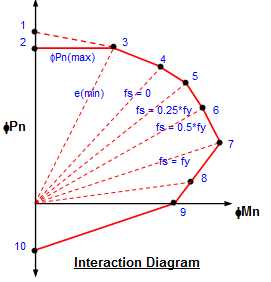
Description
"RECTBEAM" is a spreadsheet program written in MS-Excel for the purpose of analysis/design of rectangular beam or column sections. Specifically, the required flexural reinforcing, ultimate moment capacity, bar spacing for crack control, moments of inertia for deflection, beam shear and torsion requirements, and member capacity for flexure (uniaxial and biaxial) with axial load are calculated. There is also a worksheet which contains
reinforcing bar data tables.
This program is a workbook consisting of eleven (11) worksheets, described as follows:
Worksheet NameDescription
- Doc - Documentation sheet
- Complete Analysis - Beam flexure, shear, crack control, and inertia
- Flexure(As) - Flexural reinforcing for singly or doubly reinforced beams/sections
- Flexure(Mn) - Ultimate moment capacity of singly or doubly reinforced beams/sections
- Crack Control - Crack control - distribution of flexural reinforcing
- Shear - Beam or one-way type shear
- Torsion - Beam torsion and shear
- Inertia - Moments of inertia of singly or doubly reinforced beams/sections
- Uniaxial - Combined uniaxial flexure and axial load
- Biaxial - Combined biaxial flexure and axial load
- Rebar Data - Reinforcing bar data tables
Program Assumptions and Limitations:
1. This program follows the procedures and guidelines of the ACI 318-99 Building Code.
2. The "Complete Analysis" worksheet combines the analyses performed by four (4) of the individual worksheets all into one. This includes member flexural moment capacity, as well as shear, crack control, and inertia calculations. Thus, any items below pertaining to any of the similar individual worksheets included in this one are also applicable here.
3. In the "Flexure(As)" worksheet, the program will display a message if compression reinforcing is required, when the beam/section cannot handle the ultimate design moment with tension reinforcing only. Then a doubly-reinforced design is performed.
4. In the "Flexure(As)" worksheet for a singly reinforced beam/section, when the required flexural reinforcing is less than the Code minimum, then the program will use the lesser value of either 4/3 times the required value or the minimum value as the amount to actually use for design.
5. In the "Flexure(Mn)", "Uniaxial", and "Biaxial" worksheets, when the calculated distance to the neutral axis, 'c', is less than the distance to the reinforcement nearest the compression face, the program will ignore that reinforcing and calculate the ultimate moment capacity based on an assumed singly-reinforced section.
6. In the "Uniaxial" and "Biaxial" worksheets, the CRSI "Universal Column Formulas" are used by this program to determine points #1 through #7 of the 10 point interaction curve.
7. In the "Uniaxial" and "Biaxial" worksheets, the CRSI "Universal Column Formulas", which are used by this program, assume the use of the reinforcing yield strength, fy =60 ksi.
8. In the "Uniaxial" and "Biaxial" worksheets, this program assumes a "short", non-slender rectangular column with symmetrically arranged and sized bars.
9. In the "Uniaxial" and "Biaxial" worksheets, for cases with axial load only (compression or tension) and no moment(s) the program calculates total reinforcing area as follows:
Ast = (Ntb*Abt) + (Nsb*Abs) , where: Abt and Abs = area of one top/bottom and side bar respectively.
10. In the "Uniaxial" and "Biaxial" worksheets, for pure moment capacity with no axial load, the program assumes bars in 2 outside faces parallel to axis of bending plus 50% of the total area of the side bars divided equally by and added to the 2 outside faces, and program calculates reinforcing areas as follows:
for X-axis: As = A's = ((Ntb*Abt) + (0.50*Nsb*Abs))/2
for Y-axis: As = A's = ((Nsb*Asb+4*Atb) + (0.50*(Ntb-4)*Atb))/2
11. In the "Uniaxial" and "Biaxial" worksheets, design capacities, fPn and fMn, at design eccentricity, e = Mu*12/Pu, are determined from interpolation within the interaction curve for each axis.
12. In the "Uniaxial" and "Biaxial" worksheets, when the design eccentricity falls between the "balanced" point (Point #7) and point of pure flexure (Point #9) the program uses f = 0.7 at Point #7 and f = 0.9 at Point #9. However, it should be noted that the Code permits the value of 'f' to be increased linearly from a starting value of 0.70 at fPn = 0.1*f 'c*Ag (Point #8), up to the maximum value of 0.9 at Point #9, using:
f = 0.90 - 2*Pu/(f 'c*Ag).
13. In the "Biaxial" worksheet, the biaxial capacity is determined by the following approximations:
a. For Pu >= 0.1*f'c*Ag, use Bresler Reciprocal Load equation:
1/fPn = 1/fPnx + 1/fPny - 1/fPo
Biaxial interaction stress ratio, S.R. = Pu/fPn <= 1
b. For Pu < 0.1*f'c*Ag, use Bresler Load Contour interaction equation:
Biaxial interaction stress ratio, S.R. = (Mux/fMnx)^1.15 + (Muy/fMny)^1.15 <= 1
14. The "Rebar Data" worksheet contains tables of reinforcing bar data which include various bar properties,reinforcing bar areas based on spacing, and various plain welded wire fabric properties.
15. This program contains numerous “comment boxes” which contain a wide variety of information including explanations of input or output items, equations used, data tables, etc. (Note: presence of a “comment box” is denoted by a “red triangle” in the upper right-hand corner of a cell. Merely move the mouse pointer to the desired cell to view the contents of that particular "comment box".)
This repository also includes "RECTBEAM (318-05).xls" which uses the ACI 318-05 Code.
Calculation Reference
ACI 318-99 Building Code
Calculation Preview
Full download access to any calculation is available to users with a paid or awarded subscription (XLC Pro).
Subscriptions are free to contributors to the site, alternatively they can be purchased.
Click here for information on subscriptions.
ganti
**ATomanovich wrote:**
I've had a few other folks with the same reuest for metric versions. I personally have never worked on an all-metric required project in my 36 of practice, however that's not to say that it won't still come. However, since I do these spreadsheets on my own time and distribute them freely, I'm obviously inclined to do what facilitates my own work and the work of the people that surround me.
Since I'm still a practicing engineer, finding the time to do all that I have on my wish list is a very difficult task at best. Also, not being experienced with metric units, I'm not even sure what the commonly used set of units would be for replacing feet, inches, kips, ft-kips, ksf, ksi, and psi.
As you know, all my spreadsheets are protected, but not with a password. Thus, I encourage you or others to have a go at it. You could reach me by email via my forum contact information if you wanted me to review what you have done. That's the best answer that I can give you for the moment.
Alex
No, the CRSI "Universal Column Formulas"are from the CRSI Design Handbook, 8th Edition, 1996, pages 3-225 to 3-230.
I was incorrect in my statement that the ACI 318-02 and ACI 318-05 Codes state that you may still use ACI 318-99. That is not exactly true. What I actually meant was that Appendix C in ACI 318-05 gives you the load factors and "phi" factors that can be used as an alternative. The "phi" factor for tied compression members is shown 0.70, same as in ACI 318-99, and the ultimate load factors are for the most part the same as in ACI 318-99. The main difference is that you cannot take a 0.75 reduction times the D+L+W load combination, as was allowed in ACI 318-99. As long as you use the correct load factors and load combinations from ACI 318-05 Appendix C, you can use the column worksheets from the RECTBEAM.xls workbook, because you are prompted for the ultimate factored loads, and the "phi" factor used is 0.70.
That's my take on it anyway.
Alex
I am assuming you are referring to the Maunual of Standard Practice. Is that correct? I have a copy of the Design Handbook from 1993 and 2002 and couldn't find any reference to these equations.
I did note that ACI 318-05 permits the use of the CRSI Handbook (2002) or the ACI design handbook (1997, which uses 318-95). Where does it make reference to ACI 318-99? Feels like I've been chasing my tail to make sure I stay consistent throughout the entire process.
The CRSI “Universal Column Formulas” are from editions of the CRSI Manual from the mid to late 1990’s. As far as I know CRSI has not republished these formulas, reflecting the change in the “phi” factor from 0.70 to 0.65. I wish that they would, because I plan to create an updated version on the RECTBEAM.xls workbook. For now, in the 2 colum worksheets my best bet is to ratio down the original “Universal Column Formulas” formulas by a factor of 0.65/0.70. Problem is, the way those equations are expressed and simplified down, it does not make it readily apparent where to make those adjustments. I will get it figured out…..hopefully.
Remember that both the ACI 318-02 and ACI 318-05 Codes still permit the use of the ACI 318-99 Code, as long as the applicable “phi” factors and ultimate load factors for that prior code are still used as a matter of consistency.
Alex

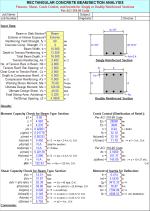
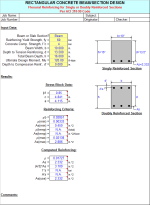
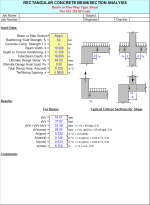
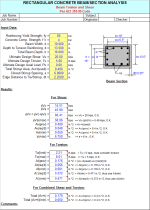
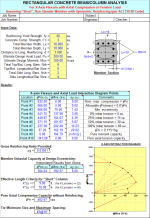
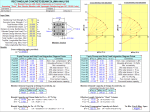
Thank you so much for sharing your wisdom and knowledge!
Michael Jones